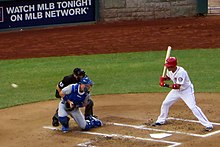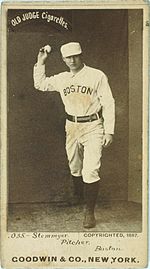In baseball, an earned run is any run that was fully enabled by the offensive team's production in the face of competent play from the defensive team. Conversely, an unearned run is a run that would not have been scored without the aid of an error or a passed ball committed by the defense.
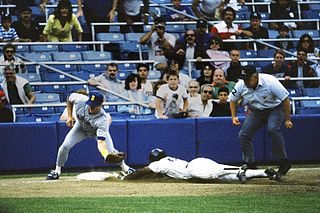
In baseball, a stolen base occurs when a runner advances to a base unaided by other actions and the official scorer rules that the advance should be credited to the action of the runner. The umpires determine whether the runner is safe or out at the next base, but the official scorer rules on the question of credit or blame for the advance under Rule 10 of the MLB's Official Rules.

In baseball, a catcher is charged with a passed ball when he fails to hold or control a legally pitched ball that, with ordinary effort, should have been maintained under his control, and, as a result of this loss of control, the batter or a runner on base advances. A runner who advances due to a passed ball is not credited with a stolen base unless he breaks for the base before the pitcher begins his delivery.

A knuckleball or knuckler is a baseball pitch thrown to minimize the spin of the ball in flight, causing an erratic, unpredictable motion. The air flow over a seam of the ball causes the ball to change from laminar to turbulent flow. This change adds a deflecting force to the baseball, making it difficult for batters to hit but also difficult for pitchers to control and catchers to catch; umpires are challenged as well, as the ball's irregular motion through the air makes it harder to call balls and strikes. A pitcher who throws knuckleballs is known as a knuckleballer.

In baseball or softball, a strikeout occurs when a batter accumulates three strikes during a time at bat. It usually means that the batter is out. A strikeout is a statistic recorded for both pitchers and batters, and is denoted by K in scorekeeping and statistics. A "strikeout looking"—in which the batter does not swing and the third strike is called by the umpire—is usually denoted by a ꓘ.
In baseball, a triple play is the act of making three outs during the same play. There have only been 735 triple plays in Major League Baseball (MLB) since 1876, an average of just over five per season.

In baseball and softball statistics, an error is an act, in the judgment of the official scorer, of a fielder misplaying a ball in a manner that allows a batter or baserunner to advance one or more bases or allows a plate appearance to continue after the batter should have been put out. The term error is sometimes used to refer to the play during which an error was committed.

In baseball, a no-hitter is a game in which a team was not able to record a hit. Major League Baseball (MLB) officially defines a no-hitter as a completed game in which a team that batted in at least nine complete innings recorded no hits. A pitcher who prevents the opposing team from achieving a hit is said to have "thrown a no-hitter". In most cases, no-hitters are recorded by a single pitcher who throws a complete game; one thrown by two or more pitchers is a combined no-hitter.

In the game of baseball, the official scorer is a person appointed by the league to record the events on the field, and to send the official scoring record of the game back to the league offices. In addition to recording the events on the field such as the outcome of each plate appearance and the circumstances of any baserunner's advance around the bases, the official scorer is also charged with making judgment calls that do not affect the progress or outcome of the game. Judgment calls are primarily made about errors, unearned runs, fielder's choice, the value of hits in certain situations, and wild pitches, all of which are included in the record compiled. This record is used to compile statistics for each player and team. A box score is a summary of the official scorer's game record.

In baseball, an intentional base on balls, usually referred to as an intentional walk and denoted in baseball scorekeeping by IBB, is a walk issued to a batter by a pitcher with the intent of removing the batter's opportunity to swing at the pitched ball. A pitch that is intentionally thrown far outside the strike zone for this purpose is referred to as an intentional ball.

In baseball, a pitcher can commit a number of illegal motions or actions that constitute a balk. Most of these violations involve pitchers pretending to pitch when they have no intention of doing so. In games played under the Official Baseball Rules that govern professional play in the United States and Canada, a balk results in a dead ball or delayed dead ball. In certain other circumstances, a balk may be wholly or partially disregarded. Under other rule sets, notably in the United States under the National Federation of State High School Associations, a balk results in an immediate dead ball. In the event a balk is enforced, the pitch is generally nullified, each runner is awarded one base, and the batter (generally) remains at bat, and with the previous count. The balk rule in Major League Baseball was introduced in 1898.

Richard Alexander Ankiel is an American former professional baseball center fielder and pitcher. He spent most of his Major League Baseball (MLB) career with the St. Louis Cardinals, but also played for the Kansas City Royals, Atlanta Braves, Washington Nationals, Houston Astros, and New York Mets.

On September 9, 1965, Sandy Koufax of the Los Angeles Dodgers pitched a perfect game in the National League against the Chicago Cubs at Dodger Stadium.
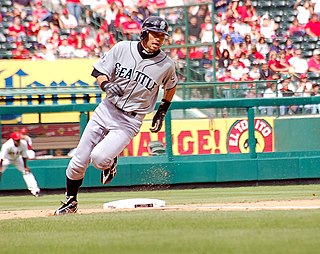
In baseball, base running is the act of running from base to base, performed by members of the team at bat.

The 2010 National League Championship Series (NLCS) was a best-of-seven game Major League Baseball playoff series that pitted the winners of the 2010 National League Division Series—the Philadelphia Phillies and San Francisco Giants—against each other for the National League Championship. The Giants would defeat the Phillies, four games to two, to advance to their first World Series since 2002. The series, the 41st NLCS in league history, began on October 16 and ended on October 23. The Phillies had home field advantage as a result of their better regular-season record. The Phillies hosted Games 1, 2 and 6, while the Giants were at home for Games 3, 4 and 5.
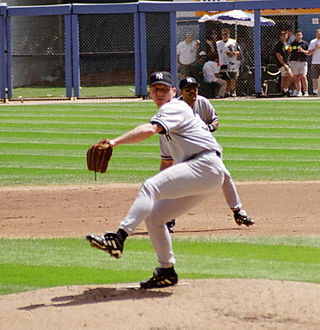
On July 18, 1999, David Cone of the New York Yankees pitched the 16th perfect game in Major League Baseball (MLB) history and the third in team history, and the first no-hit game in regular season interleague play. Cone pitched it against the Montreal Expos at Yankee Stadium in The Bronx, with 41,930 fans in attendance. The game took 2 hours and 16 minutes, from 2:05 PM ET to 4:54 PM ET. The game was interrupted by a 33-minute rain delay in the bottom of the third inning in the middle of an at-bat for Tino Martinez. As part of the day's "Yogi Berra Day" festivities honoring the Yankees' former catcher, before the game, former Yankees pitcher Don Larsen threw the ceremonial first pitch to Berra; the two comprised the battery for Larsen's perfect game in 1956.

Brooks Joseph Kriske is an American professional baseball pitcher for the Saitama Seibu Lions of Nippon Professional Baseball (NPB). He has previously played in Major League Baseball (MLB) for the New York Yankees, Baltimore Orioles, and Kansas City Royals. He has also played in NPB for the Yokohama DeNA BayStars.
